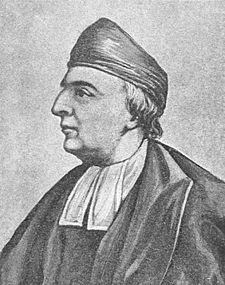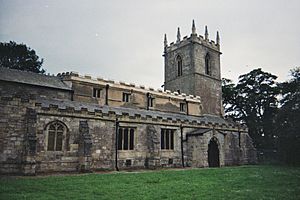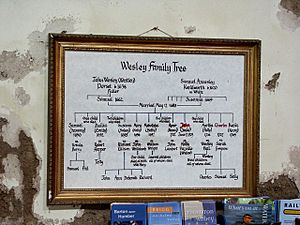Samuel Wesley (poet, died 1735) facts for kids
Quick facts for kids Samuel Wesley (poet, died 1735) |
|
 |
|
| Born | 17 December 1662 in Dorset, England |
|---|---|
| Died | 25 April 1735 (aged 72) in Epworth, Lincolnshire, England |
| Education | Exeter College, Oxford Corpus Christi College, Cambridge |
| Ordained | 17 December 1662 |
| Spouse | Susanna Wesley (m. 1688) |
| Children | 19, including John Wesley, Charles Wesley, Samuel Wesley (the Younger) and Mehetabel Wesley Wright |
| Parents | John Westley (father) |

Samuel Wesley (17 December 1662 – 25 April 1735) was a clergyman of the Church of England, a poet, and a writer. He was the father of John Wesley and Charles Wesley, the founders of Methodism.
Contents
Family and early life
Samuel Wesley was the second son of Rev. John Westley or Wesley, rector of Winterborne Whitechurch, Dorset. His mother was the daughter of John White, the rector of Trinity Church, Dorchester.
Following grammar school education in Dorchester, Wesley was sent away from home to prepare for ministerial training under Theophilus Gale. Gale's death in 1678 forestalled this plan. Instead, he attended another grammar school. After that, he studied at dissenting academies under Edward Veel in Stepney and then Charles Morton in Newington Green, where Gale had lived. Daniel Defoe also attended Morton's school. This school was situated "probably on the site of the current Unitarian church", contemporaneously with Wesley. Samuel resigned his place and his annual scholarship among the Dissenters. After that, he walked all the way to Oxford, where he enrolled at Exeter College as a "poor scholar". He functioned as a "servitor", which means he sustained himself financially by waiting upon wealthy students. He also published a small book of poems, entitled Maggots: or Poems on Several Subjects never before Handled in 1685. The unusual title is explained in a few lines from the first page of the work:
In his own defense the author writes
Because when the foul maggot bites
He ne'er can rest in quiet:
Which makes him make so sad a face
He'd beg your worship or your grace
Unsight, unseen, to buy it
Wesley married Susanna Annesley in 1688. He fathered, among others, Samuel (the younger), Mehetabel, John and Charles Wesley. He had 19 children, nine of whom died in infancy. Three boys and seven girls survived.
In 1697 he was appointed to the living at Epworth, Lincolnshire through the benevolence of Queen Mary. He may have come to the queen's attention because of his heroic poem, "The Life of Christ" (1693). He dedicated this poem to her. Wesley's high-church liturgies, academic proclivities, and loyalist Tory politics were a complete mismatch for some of his illiterate parishioners. He was not warmly received, and his ministry was not widely appreciated. Wesley was soon deep in debt and much of his life would be spent trying to make financial ends meet. In 1709 his parsonage was destroyed by fire, and his son John was barely rescued from the flames. The parsonage was rebuilt and is now known as the Old Rectory, Epworth.
Career
His poetic career began in 1685 with the publication of Maggots, a collection of juvenile verses on trivial subjects, the preface to which apologizes to the reader because the book is neither grave nor gay. The poems appear to be an attempt to prove that poetic language can create beauty out of the most revolting subject. The first poem, "On a Maggot", is composed in hudibrastics, with a diction obviously Butlerian, and it is followed by facetious poetic dialogues and by Pindarics of the Cowleian sort but on such subjects as "On the Grunting of a Hog". In 1688 Wesley took his B.A, at Exeter College, Oxford, following which he became a naval chaplain and, in 1690, rector of South Ormsby. In 1694 he took his MA from Corpus Christi College, Cambridge, and the following year he became rector of Epworth. During the run of the Athenian Gazette (1691–1697) he joined with Richard Sault and John Norris in assisting John Dunton, the promoter of the undertaking. His second venture in poetry, the Life of Our Blessed Lord and Saviour, an epic largely in heroic couplets with a prefatory discourse on heroic poetry, appeared in 1693, was reissued in 1694, and was honoured with a second edition in 1697. In 1695 he dutifully came forward with Elegies, lamenting the deaths of Queen Mary II and Archbishop Tillotson. An Epistle to a Friend concerning Poetry (1700) was followed by at least four other volumes of verse, the last of which was issued in 1717. His poetry appears to have had readers on a certain level, but it stirred up little pleasure among wits, writers, or critics. Judith Drake confessed that she was lulled to sleep by Blackmore's Prince Arthur and by Wesley's "heroics" (Essay in Defence of the Female Sex, 1696, p. 50). And he was satirized as a mere poetaster in Garth's Dispensary, in Swift's The Battle of the Books, and in the earliest issues of the Dunciad.
Theology
Samuel Wesley held Anglican Arminianist views. The Arminian Hugo Grotius, was his favourite biblical commentator. Through his sermons, he demonstrated beliefs in the tenets of Arminianism and especially in its distinctive prevenient grace.
See also


